Calculation of Transmission Line Worker Electric Field Induced Current Using Fourier-Enhanced Charge Simulation
Abstract
:1. Introduction
2. Method
2.1. Application of Thevenin’s Theorem to the Case of High-Voltage Workers
2.2. Numerical Approach for Realistic Systems
- Discretize the surface of finite conducting objects (conductors, worker, and structure) by selecting a set of points distributed on their surfaces. Known voltages are enforced at these points. Higher point density allows greater accuracy but at the cost of greater computational burden. These voltage match points must be distributed based on the nature of the geometry and expected relative electric field strength. For example, smaller geometric shapes for which surface electric fields are expected to be higher may require a denser point distribution than areas of larger geometry with smaller electric fields.
- Place point charges strategically at locations inside the object. Point charges are equal in number to the surface voltage match points and each charge point location is offset in a direction normal to the surface at its respective voltage match point. The offset distance from a surface voltage match point to its corresponding charge point is based on best practices for charge simulation but is usually about 1.5 to 2.0 times the longest distance from the respective surface voltage match point to the nearest adjacent surface voltage match points. If the number of point charges differs from the number of surface voltage match points, iterative optimization-based solution methods are needed.
- Select Fourier parameters that control spatial discretization of the conductor line charge density segments.
- Compute the line charge densities of each subconductor and the point charge values at each charge point that will satisfy the electric potential boundary conditions defined at the surfaces of the objects and phase conductors. Floating potential conditions require that a zero net charge limit be enforced on the applicable object(s) (in this case, the worker).
- Once the point charge values are identified, the electric potential can be accurately calculated anywhere in the insulating medium external to or at the surface of the conductors.
2.3. High-Voltage System Selected for Analysis
2.4. Human Model
2.5. Simulation Process
Analysis Steps
- Step 1: Calculate the open-circuit voltage.
- Step 2: Calculate the Thevenin impedance.
- Step 3: Calculate the short-circuit current.
2.6. Measurement Method
3. Results
4. Discussion
Author Contributions
Funding
Data Availability Statement
Conflicts of Interest
References
- Keesey, J.C.; Letcher, F.S. Minimum Thresholds for Physiological Responses to Flow of Alternating Electric Current Flow through the Human Body at Power-Transmission Frequencies; Project MR005.8-0030B; Naval Medical Research Institute: Bethesda, MD, USA, 1969. [Google Scholar]
- International Commission on Non-Ionizing Radiation Protection. ICNIRP guidelines for limiting exposure to time-varying electric and magnetic fields (1 Hz to 100 kHZ). Health Phys. Soc. 2010, 99, 818–836. [Google Scholar] [CrossRef] [PubMed]
- Swanson, D.W.; (Bonneville Power Administration, Portland, OR, USA). Private Communication, 2023.
- Ahmed, Y.; Rowland, S.M. UK Linesmen’s Experience of Microshocks on HV Overhead Lines. J. Occup. Environ. Hyg. 2009, 6, 475–482. [Google Scholar] [CrossRef] [PubMed]
- IEEE. 2023 National Electrical Safety Code® (NESC®); IEEE: Piscataway, NJ, USA, 2022. [Google Scholar]
- Pan, W.; Li, X.; Li, Y. Calculation and Analysis of Micro-Shock Energy of Line Maintenance Personnel in High Electric Field. In Proceedings of the 5th Asia Conference on Power and Electrical Engineering (ACPEE), Chengdu, China, 4–7 June 2020. [Google Scholar]
- Lu, T.; Li, X. Measurement of Electrostatic Discharge Through Human Body Contacting Metallic Objects Under HVAC Transmission Lines. In Proceedings of the 41st Annual EOS/ESD Symposium (EOS/ESD), Riverside, CA, USA, 15–20 September 2019. [Google Scholar]
- He, W.; Zhang, Y.; Liu, Y.; Chen, Q.; Han, X.; Zhou, D.; Wei, H.; Wan, B. Experimental Study on the Transient Electric Shock Characteristics Between Metal Sheds and the Human Body Near Ultrahigh Voltage Alternating Current Transmission Lines. IEEE Trans. Electromagn. Compat. 2023, 65, 679–688. [Google Scholar] [CrossRef]
- Ahmed, Y.; Rowland, S.M.; Burnett, G.; Pammenter, N. Avoidance of Microshocks for HV Overhead Line Workers. In Proceedings of the International Conference on Electric and Magnetic Fields at Extremely Low Frequencies, Paris, France, 24–25 March 2011. [Google Scholar]
- Martinsen, Ø.G.; Grimnes, S.; Piltan, H. Cutaneous Perception of Electrical Direct Durrent. ITBM-RBM 2004, 25, 240–243. [Google Scholar] [CrossRef]
- Prausnitz, M.R. The Effects of Electric Current Applied to Skin: A Review for Transdermal Drug Delivery. Adv. Drug Deliv. Rev. 1996, 18, 395–425. [Google Scholar] [CrossRef]
- Gunatilake, A.; Ahmed, Y.; Rowland, S.M. Modelling of Microshocks Associated With High-Voltage Equipment. IEEE Trans. Power Deliv. 2009, 24, 202–207. [Google Scholar] [CrossRef]
- Ahmed, Y.; Rowland, S.M. Modelling Linesmen’s Potentials in Proximity to Overhead Lines. IEEE Trans. Power Deliv. 2009, 24, 2270–2275. [Google Scholar] [CrossRef]
- Lin, C.J.; Chuang, R.; Chen, M. Steady-state and Shock Currents Induced by ELF Electric Fields in a Human Body and a Nearby Vehicle. IEEE Trans. Electromagn. Compat. 1990, 32, 59–65. [Google Scholar] [CrossRef]
- Abdel-Salam, M.; Abdallah, H.M. Transmission-Line Electric Field Induction in Humans Using Charge Simulation Method. IEEE Trans. Biomed. Eng. 1995, 42, 1105–1109. [Google Scholar] [CrossRef] [PubMed]
- Leman, J.T.; Olsen, R.G. Fourier Enhanced Charge Simulation Method for Electrostatic Analysis of Overhead Transmission Lines. IEEE Trans. Power Deliv. 2022, 37, 1078–1087. [Google Scholar] [CrossRef]
- Olsen, R.G.; Leman, J.T. On Calculating Contact Current for Objects Insulated from the Earth and Immersed in Quasi-static Electric Fields. IEEE Power Energy Technol. Syst. J. 2017, 4, 16–23. [Google Scholar] [CrossRef]
- Leman, J.T.; Olsen, R.G. On Calculating the Phase-to-Phase CFO of Overhead Transmission Lines Based on the Spatial Minimum Electric Field. IEEE Trans. Power Deliv. 2022, 37, 3698–3708. [Google Scholar] [CrossRef]
- Co, G.E. Transmission Line Reference Book—345 kV and Above, 2nd ed.; Electric Power Research Institute: Palo Alto, CA, USA, 1982. [Google Scholar]
- Bladel, J.V. Electromagnetic Fields, 2nd ed.; Wiley-IEEE Press: Hoboken, NJ, USA, 2007. [Google Scholar]
- Choi, J.M.; Kim, T.W. Humidity Sensor Using an Air Capacitor. Trans. Electr. Electron. Mater. 2013, 14, 182–186. [Google Scholar] [CrossRef]
- Salas-Sánchez, A.; Rauch, J.; López-Martín, M.; Rodríguez-González, J.; Franceschetti, G.; Ares-Pena, F. Feasibility Study on Measuring the Particulate Matter Level in the Atmosphere by Means of Yagi-Uda-Like Antennas. Sensors 2020, 20, 3225. [Google Scholar] [CrossRef] [PubMed]
- Li, T.; Lin, Q.; Chen, G. Live-Line Operation and Maintenance of Power Distribution Networks; China Electric Power Press: Beijing, China, 2017. [Google Scholar]
- Morrison, R. Digital Circuit Boards: Mach 1 GHz; John Wiley & Sons: Hoboken, NJ, USA, 2012. [Google Scholar]
- Beardsmore, D. L6–Telcontar.net. Available online: https://telcontar.net/Power/pylons/L6 (accessed on 31 August 2023).
- Huysmans, T.; Molenbroek, J. DINED/Anthropometry in Design. 2023. Available online: https://dined.nl/en (accessed on 21 May 2023).
- Olsen, R.G. High Voltage Overhead Transmission Line Electromagnetics—Volume I, 2nd ed.; CreateSpace: Scotts Valley, CA, USA, 2018. [Google Scholar]
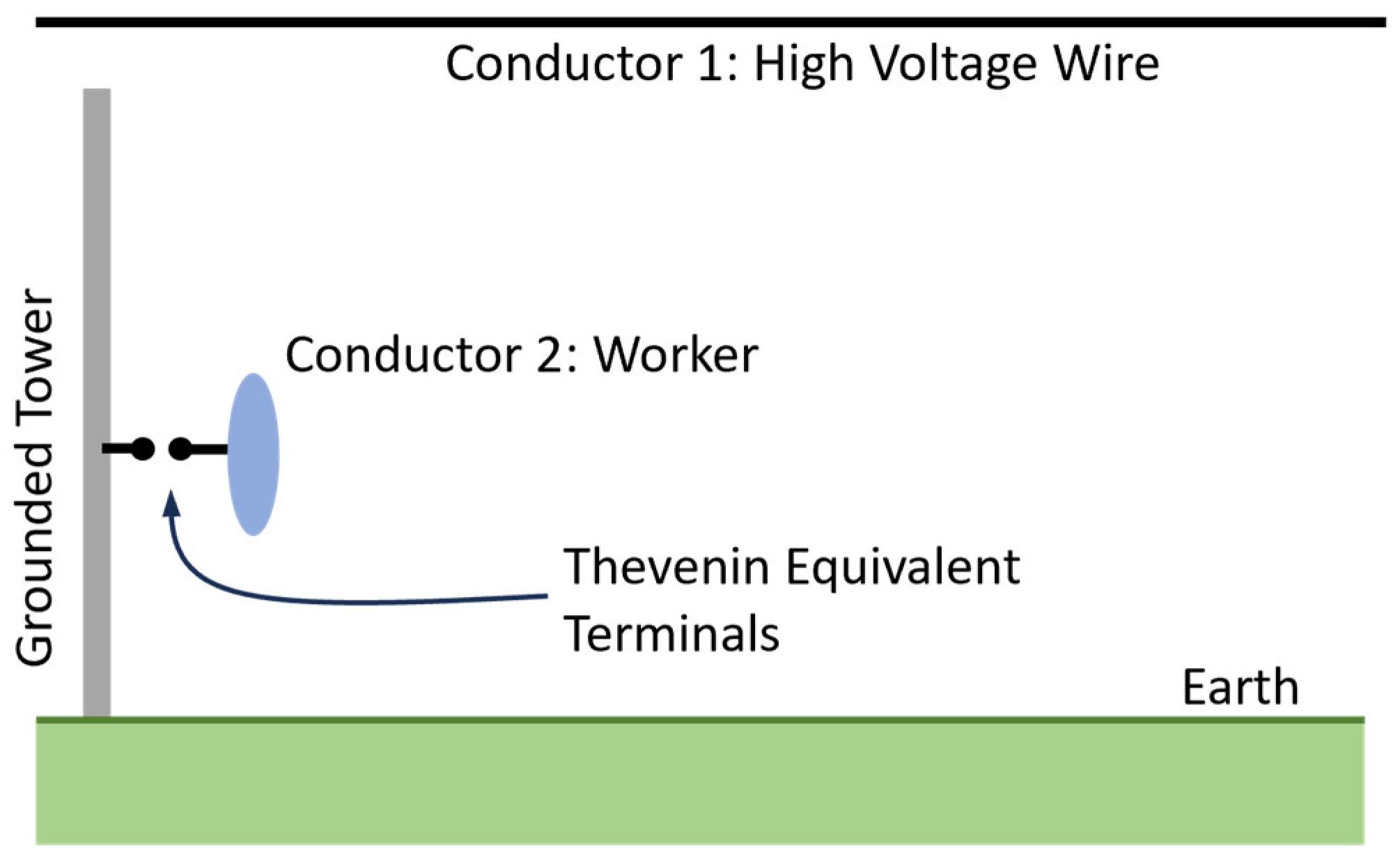


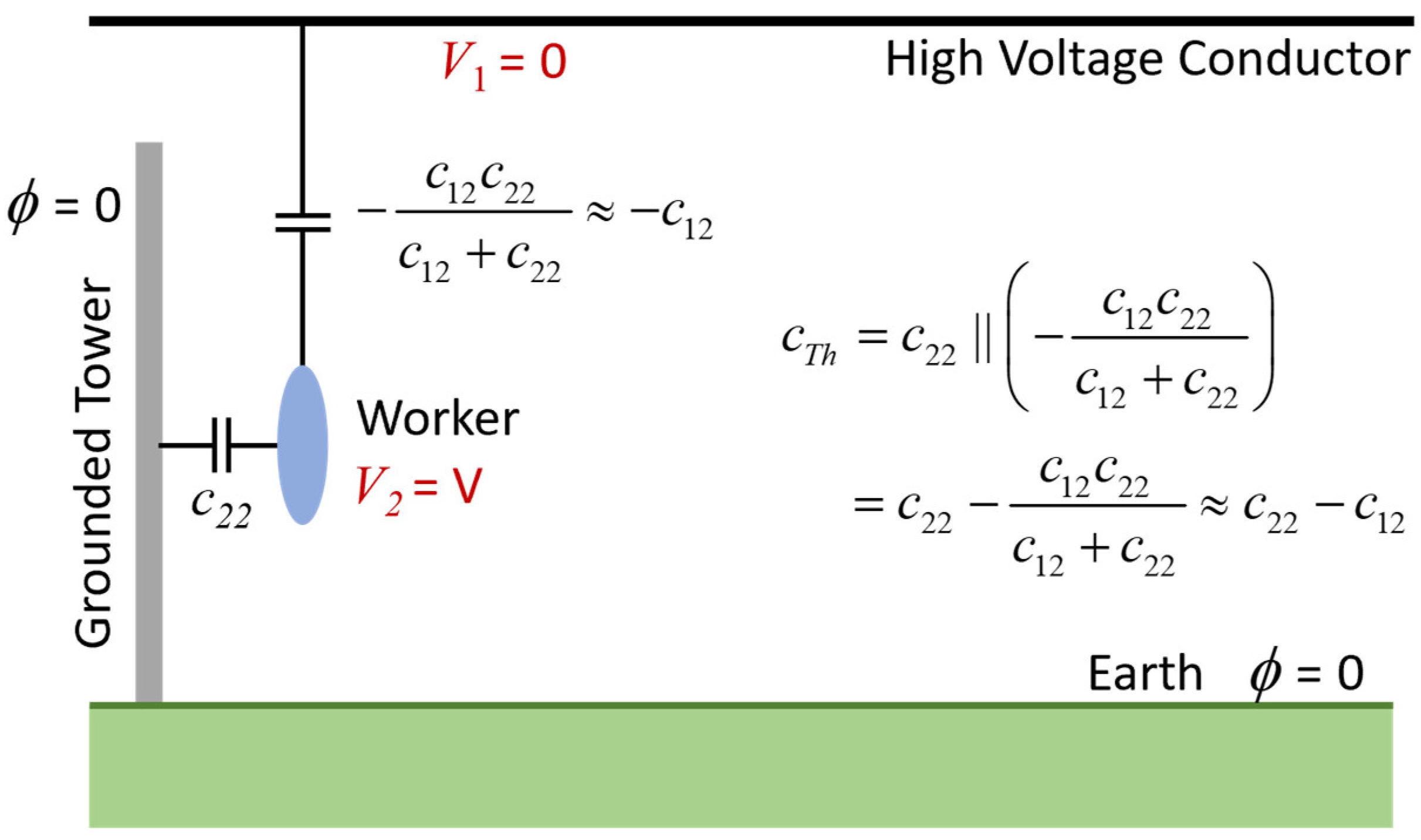
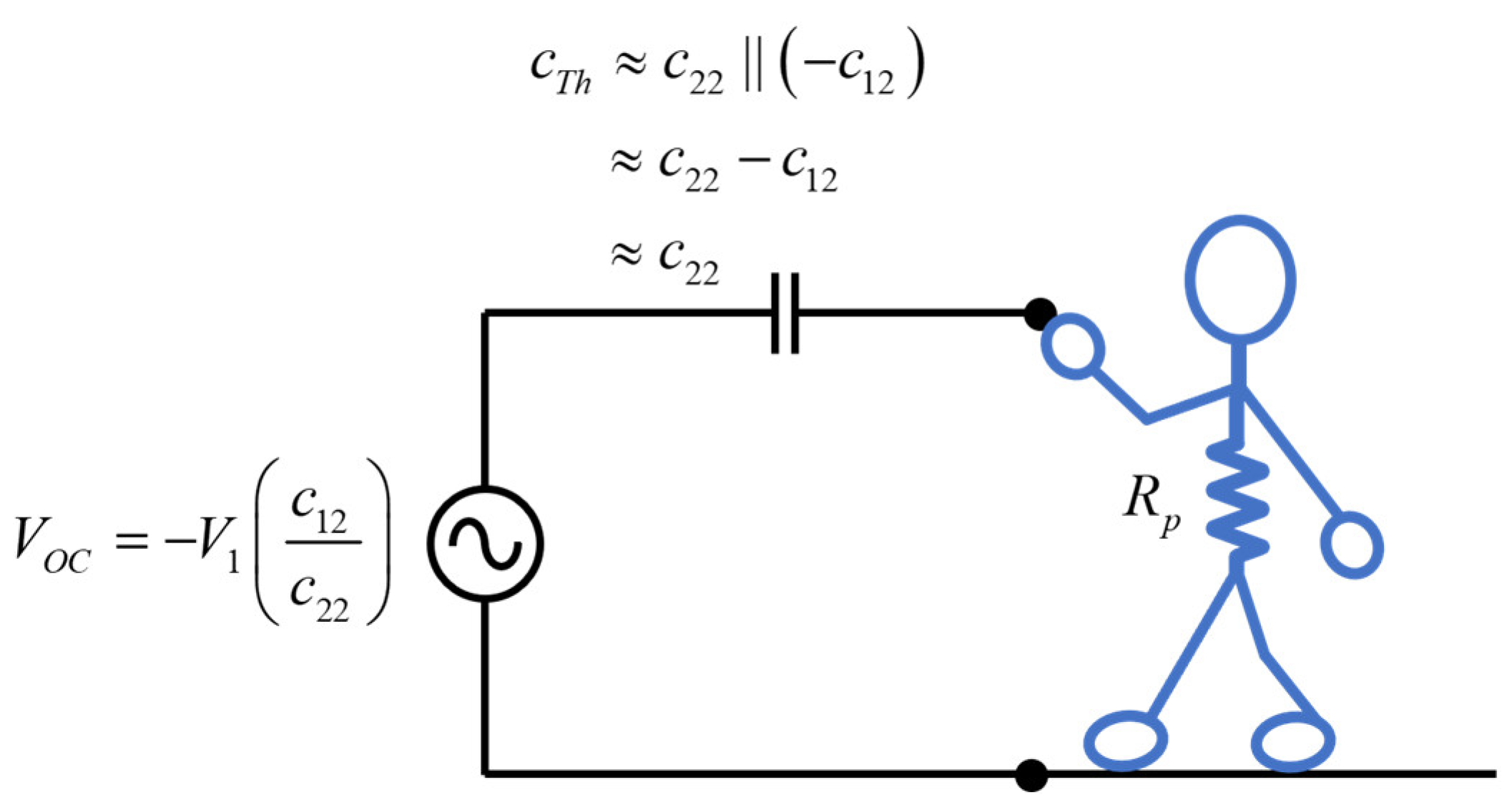
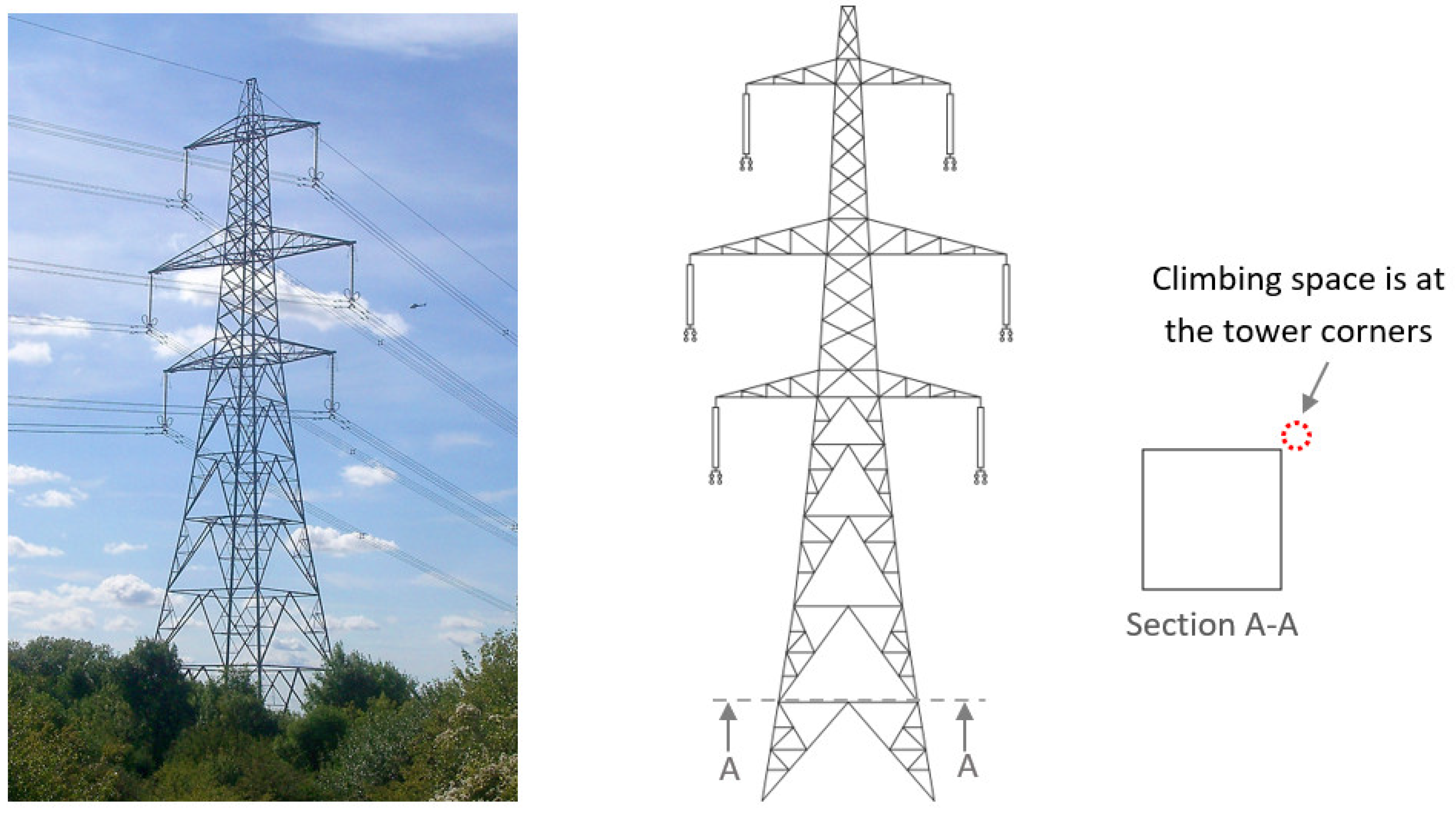
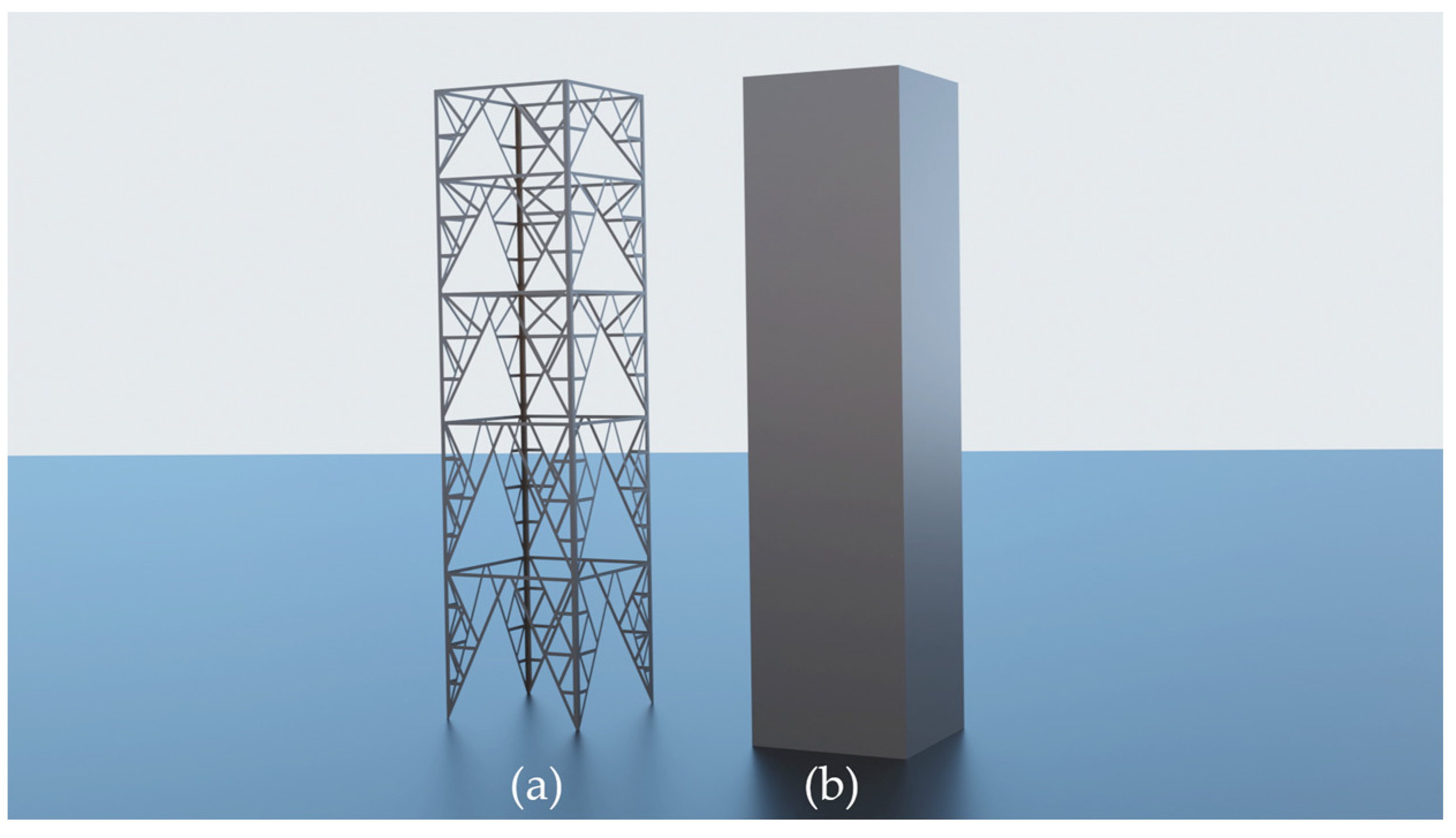
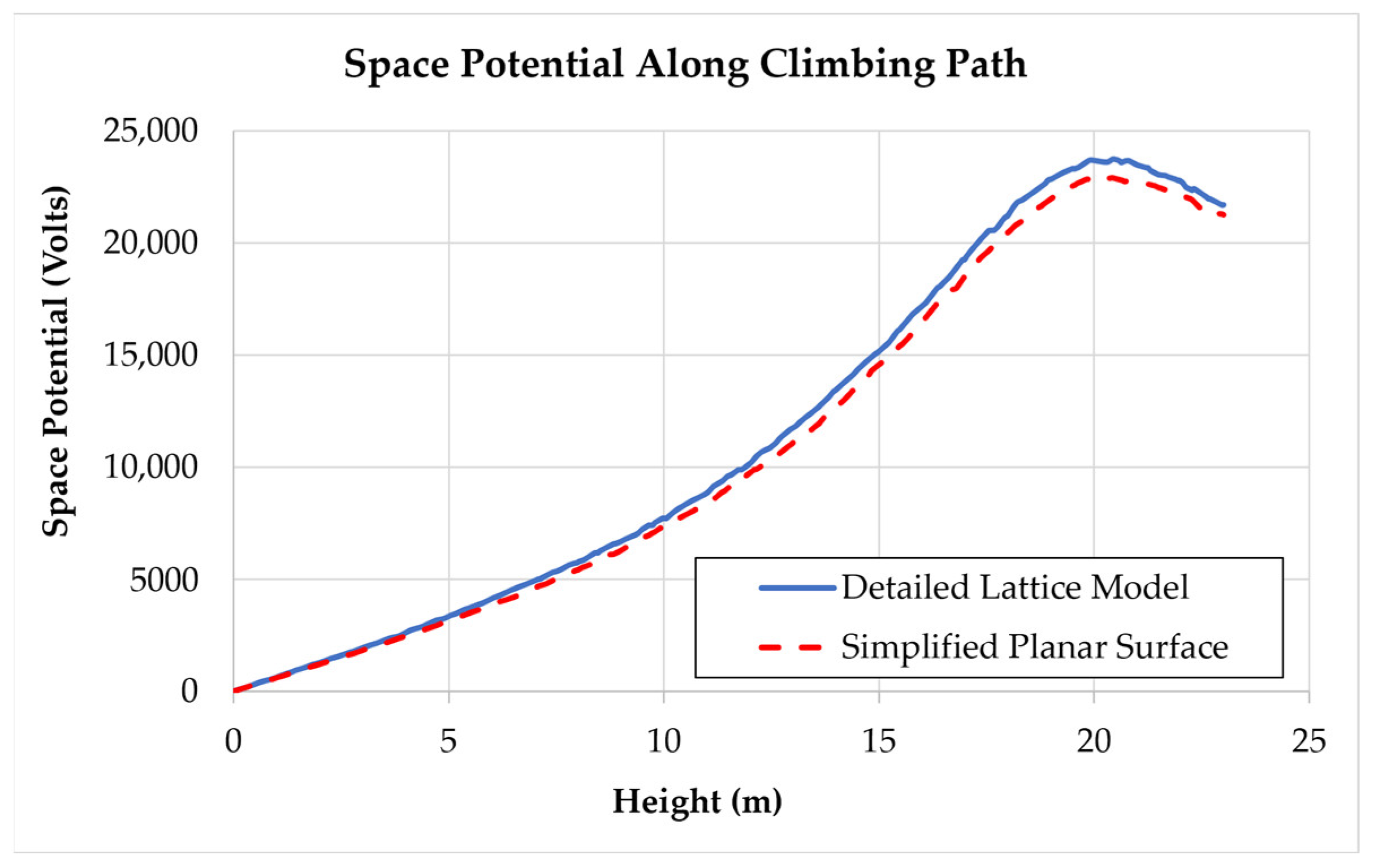
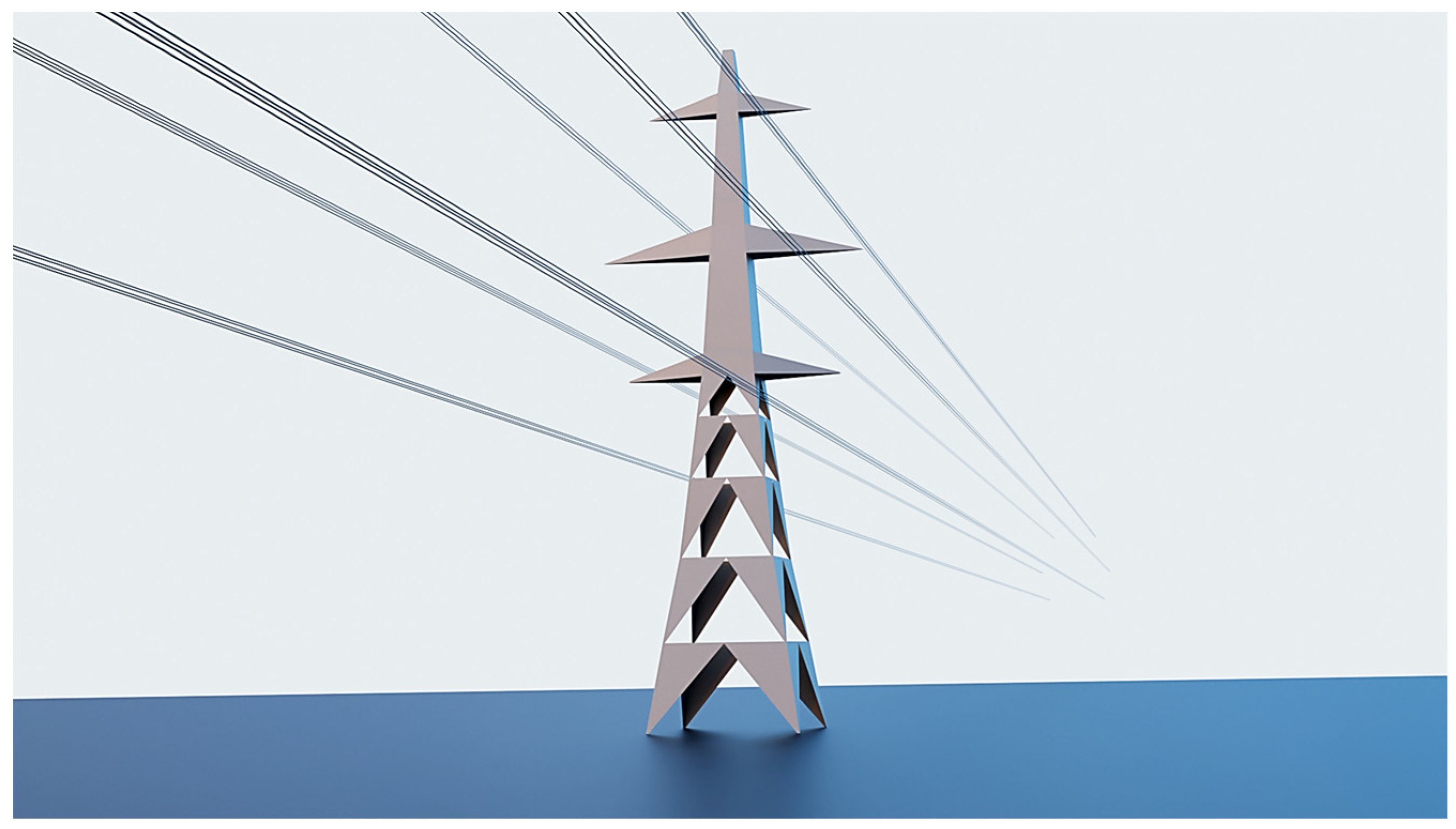
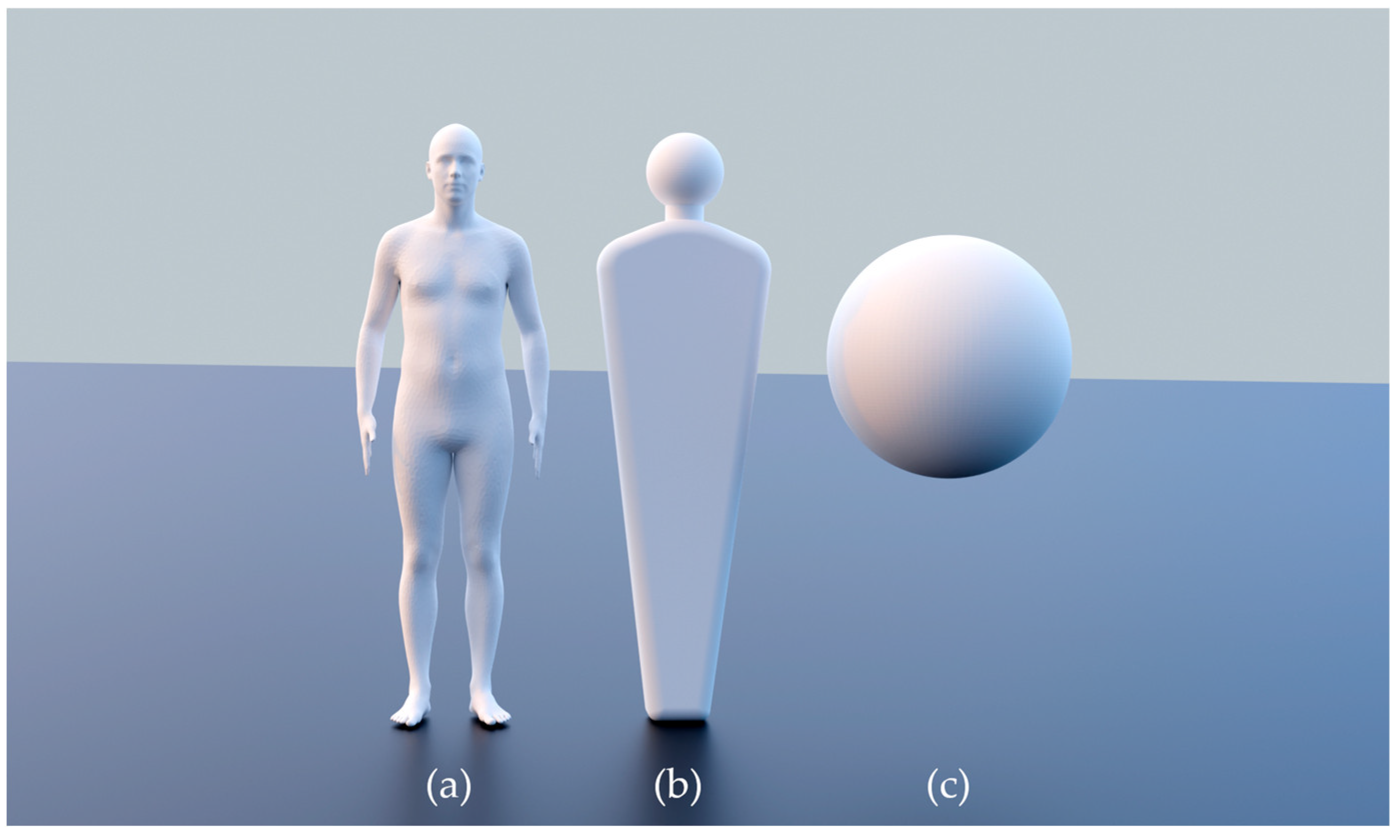

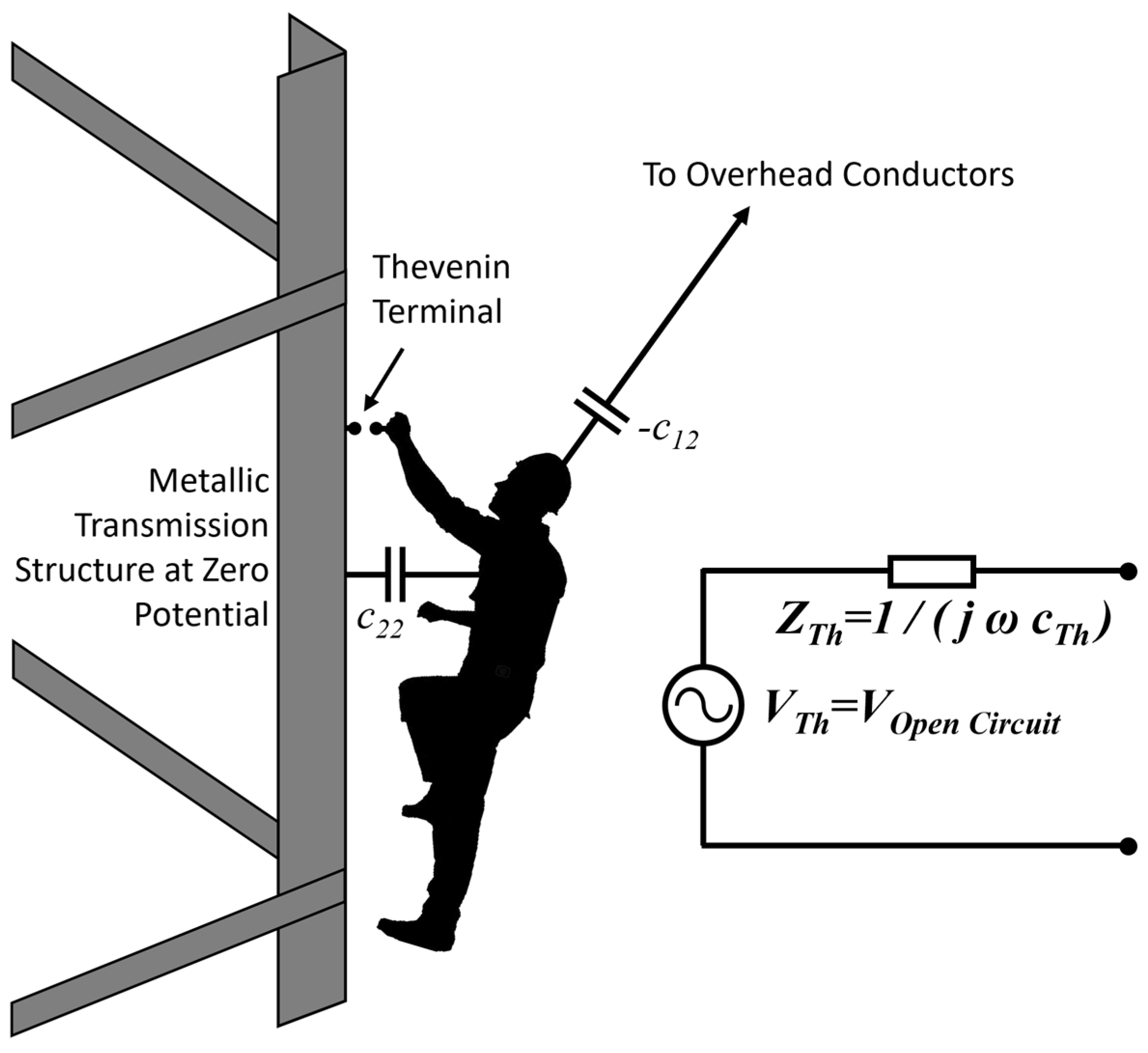
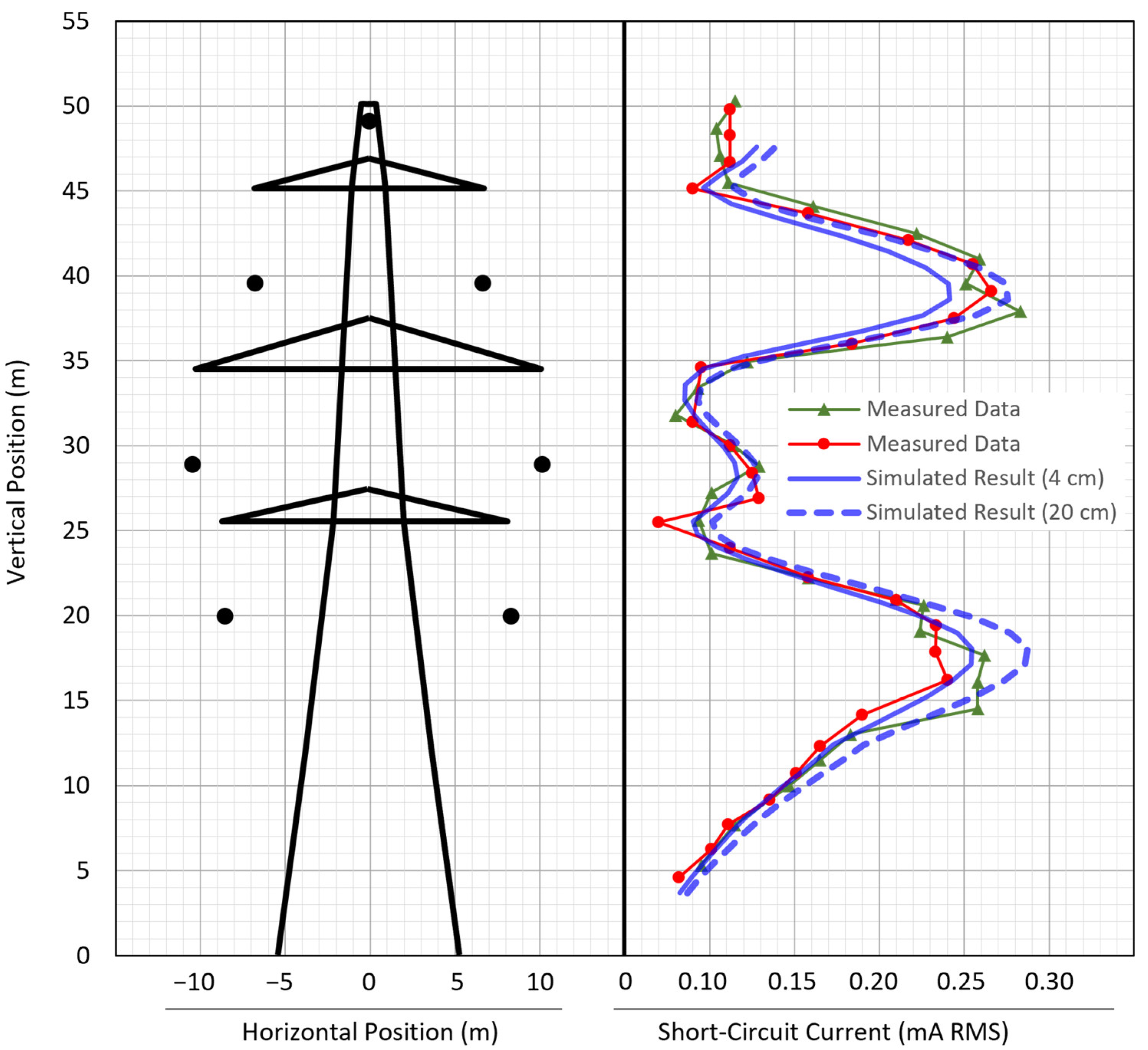

| Worker State | Description |
|---|---|
| Steady-state condition in which the worker is insulated from, but positioned on, the grounded structure | Based on the electric field, the worker is at some floating potential and has approximately zero net charge. Conduction currents through air and insulated clothing are negligible. A displacement current (i.e., capacitive current) causes a fundamental frequency redistribution of the surface charge on the worker which may or may not be perceived but is not painful because it is distributed over the whole body. |
| Steady-state condition in which the worker is in contact with the grounded structure | The worker is a grounded electrode that extends into the space between the tower and conductors. The charge is transferred between the tower (ground) and the worker to counter electric fields and maintain zero potential. The current is effectively the same in magnitude to that of the insulated condition because, in both cases, the current is limited by the capacitance between the energized conductors and the worker. However, in this case the current is concentrated at the location of contact. The sensation will depend in part on the actual surface area of that contact location. A larger contact area will reduce sensation severity. |
| Transient condition representing the transition period between the worker being insulated and in contact. | In this state, the worker is either in the process of making or breaking contact with the grounded structure. Small transient impulses occur as arcs develop over very short distances between the structure and the point of contact on the worker. The amplitude of these impulse currents can be orders of magnitude higher that the steady-state currents, but the duration of the current pulses tend to be less than one microsecond [6,7,8]. The transient currents are concentrated on a small area of the skin due to the small diameter of the arc channel between the skin and the tower. |
| Simulated Results | ||||
|---|---|---|---|---|
| 4 cm Spacing | 20 cm Spacing | Average | ||
| Measured Results | Linesman 1 | 8.14% | −8.53% | −0.19% |
| Linesman 2 | 3.30% | −14.5% | −5.59% | |
| Average | 6.45% | −10.6% | −2.08% | |
| Human Model Size * (Percent of Surface Area Relative to the Nominal Case) | Open-Circuit Voltage (Volts rms) | Model Capacitance (Picofarads) | Short-Circuit Current (Milliamperes) | Space Potential without Model (Volts rms) |
|---|---|---|---|---|
| 80% | 7900 | 67.1 | 0.167 | 8085 |
| 90% | 8239 | 71.1 | 0.184 | 8449 |
| 100% | 8562 | 74.7 | 0.201 | 8808 |
| 110% | 8841 | 78.4 | 0.218 | 9156 |
| 120% | 9118 | 81.9 | 0.235 | 9486 |
| Model * | Open-Circuit Voltage (Volts rms) | Model Capacitance (Picofarads) | Short-Circuit Current (Milliamperes) | Space Potential without Model (Volts rms) |
|---|---|---|---|---|
| Sphere | 11,538 | 64.2 | 0.233 | 12,817 |
| Human analog | 11,881 | 64.2 | 0.240 | 12,358 |
| Detailed human | 11,916 | 63.0 | 0.236 | 11,937 |
| Parameter | Value | Comment |
|---|---|---|
| a | 0.137 m | GMR for a quad bundle with spacing of 0.305 m and subconductor diameter of 2.861 cm, calculated using standard equations in [2]. |
| d | 0.44 m | Human model is about 0.3 m in depth. Average distance from the front of the person to the tower surface is about 14 cm (4 cm at the feet with a tower surface slope of about 8:1 at the height of the lowest conductor). |
| h | 5.26 m | Approximately 5.7 m from the center of the lowest bundle to the surface of the tower. |
| VLG | 230.94 kV | 400 kV line-to-line nominal voltage (rms) at a frequency of 50 Hz. |
| VOC | 8075 Volts | Volts rms calculated using (19). |
| cTh | 80 pF | The high end of the suggested range. |
| Ishort-circuit | 0.203 mA rms | Compare to the maximum simulated result of 0.204 mA rms. |
Disclaimer/Publisher’s Note: The statements, opinions and data contained in all publications are solely those of the individual author(s) and contributor(s) and not of MDPI and/or the editor(s). MDPI and/or the editor(s) disclaim responsibility for any injury to people or property resulting from any ideas, methods, instructions or products referred to in the content. |
© 2023 by the authors. Licensee MDPI, Basel, Switzerland. This article is an open access article distributed under the terms and conditions of the Creative Commons Attribution (CC BY) license (https://creativecommons.org/licenses/by/4.0/).
Share and Cite
Leman, J.T.; Olsen, R.G.; Renew, D. Calculation of Transmission Line Worker Electric Field Induced Current Using Fourier-Enhanced Charge Simulation. Energies 2023, 16, 7646. https://doi.org/10.3390/en16227646
Leman JT, Olsen RG, Renew D. Calculation of Transmission Line Worker Electric Field Induced Current Using Fourier-Enhanced Charge Simulation. Energies. 2023; 16(22):7646. https://doi.org/10.3390/en16227646
Chicago/Turabian StyleLeman, Jon T., Robert G. Olsen, and David Renew. 2023. "Calculation of Transmission Line Worker Electric Field Induced Current Using Fourier-Enhanced Charge Simulation" Energies 16, no. 22: 7646. https://doi.org/10.3390/en16227646
APA StyleLeman, J. T., Olsen, R. G., & Renew, D. (2023). Calculation of Transmission Line Worker Electric Field Induced Current Using Fourier-Enhanced Charge Simulation. Energies, 16(22), 7646. https://doi.org/10.3390/en16227646






